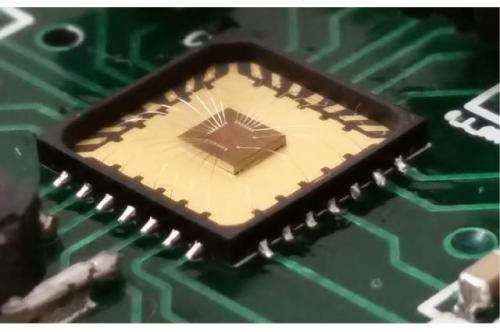New oscillator for low-power implantable transcievers

Arash Moradi and Mohamad Sawan from Polytechnique Montreal in Canada discuss their new low-power VCO design for medical implants. This oscillator was implemented to provide the frequency deviation of frequency-shift-keying (FSK) modulation in implantable radio-frequency (RF) transceivers.
How are wireless RF transceivers used in medical applications?
Implantable medical sensors keep short-range wireless communication a challenging and hot research topic for the monitoring and detection of various health parameters, such as temperature, pressure, oxygenation, seizures and other signs of diseases. For instance, the continuous monitoring of oxygen levels of the blood for patients suffering from epilepsy may help locate, treat and even prevent the emergence of seizures, thanks to low-power, high-data-rate wireless links. Even monitoring the behaviour of freely-moving animals, where light and free-running circuits are demanded, offers the chance to extract medical information in realistic conditions.
Why is it so challenging to build wireless RF transceivers for implantable sensors?
The constraints of the RF transceivers for wireless body area networks are different from conventional ones. The two main challenges are reducing the size and the power consumption of the transmitter front-end to maintain real-time, long-term data transmission. Thanks to CMOS technology, the small size of the wireless interface helps to get rid of most of the external bulky components. In practice, since the implanted devices have limited power storage, different circuits and systems design techniques have to be invented to achieve an energy-efficient communication interface. The battery cell of the current power-hungry wireless transmitter in existing medical implants has to be recharged or replaced through frequent medical surgeries, which is not adequate, and the transmitter power budget may be notably reduced.
What motivated you to develop a new low power VCO?
As reported in the literature, crystal-less and inductor-less voltage-controlled oscillators (VCOs) help to implement the fundamental building blocks in implantable and VLSI systems with different frequency ranges. Specifically, in widely-used binary FSK-based transceiver architectures, the carrier frequency gets shifted up and down by a frequency deviation to distinguish between the signal levels low (0) and high (1). Such frequency deviation is usually defined by differential quadrature signals that can be generated by cascaded flip-flops acting as a frequency divider fed by an external reference clock or crystal oscillators. However, crystal oscillators may not be suitable for integrated and implantable sensors. The frequency may also vary, depending on the application and the available channel bandwidth. As a result, a quadrature VCO (QVCO) is designed to provide the required quadrature signals with specific characteristics to help realise the target energy-efficient FSK-based RF transceiver.
Previous VCOs with such frequency range did not offer all the desired features including consuming small current and providing rail-to-rail, differential and quadrature versions of the signal at the same time.
Can you describe the design of the VCO reported in your Electronics Letters paper?
Our low-power differential rail-to-rail QVCO is composed of a 2-stage quadrature oscillator, where each stage is acting similar to a bi-stable circuit triggered by the output of the other one. This can be considered as a ring oscillator where no external clock signal is required and facilitates the integration of the oscillator; therefore, it only needs a small silicon area and a low current consumption. The start-up circuit is also designed to initiate the oscillation and is then automatically disconnected from the oscillator's circuit so as not to affect the oscillation.
Single-ended variable-frequency ring-oscillators have been already presented with similar frequency and power range to the new QVCO. However, this is the first design of a fully-integrated low-power QVCO that is capable of providing rail-to-rail, differential and quadrature versions of a variable-frequency signal, simultaneously.
When will you have a prototype?
The first prototype of the designed QVCO is in the fabrication and packaging process and is due to be tested soon. Challenges include the parasitic capacitance and resistance within the test-setup, as well as probing itself, which may play major roles in changing the behaviour of the expected output signals. Besides, producing the input signals – including the ones for enabling or disabling different blocks – with proper falling and rising time and providing the power supply, will have to be carefully planned.
We plan to use a functional implemented QVCO as an actual block to characterise the target implemented RF transceiver. More controlling signals may be added in future prototypes so that it can be used for several communication applications with different frequency and current ranges, such as providing the optimum carrier frequency for wireless power transfer using inductive links.
How do you see this technology developing in the future?
Wireless link technologies are increasing, in particular in implantable medical devices, where very low-power circuits and systems are necessary. Nowadays, a typical wireless link may occupy up to 90% of the device's total power consumption. Recent deep sub-micron technologies look promising in allowing the improvement of the speed with much lower power leakage and smaller size, which will help designers to improve the performance of the wireless links of these devices.
To help this field progress, we would like to see better connection of academic and industrial researchers, as shared access to various deep sub-micron technologies may widen the window to develop new ideas in circuits and systems designs.
More information: "Differential rail-to-rail voltage-controlled quadrature ring oscillator for low-power implantable transceivers." Electronics Letters, Volume 50, Issue 22, 23 October 2014, p. 1568 – 1570. DOI: 10.1049/el.2014.2964
Journal information: Electronics Letters
Provided by Institution of Engineering and Technology
This story is published courtesy of Electronics Letters. For additional Electronics Letters news and features visit theiet.org/eletters.



















